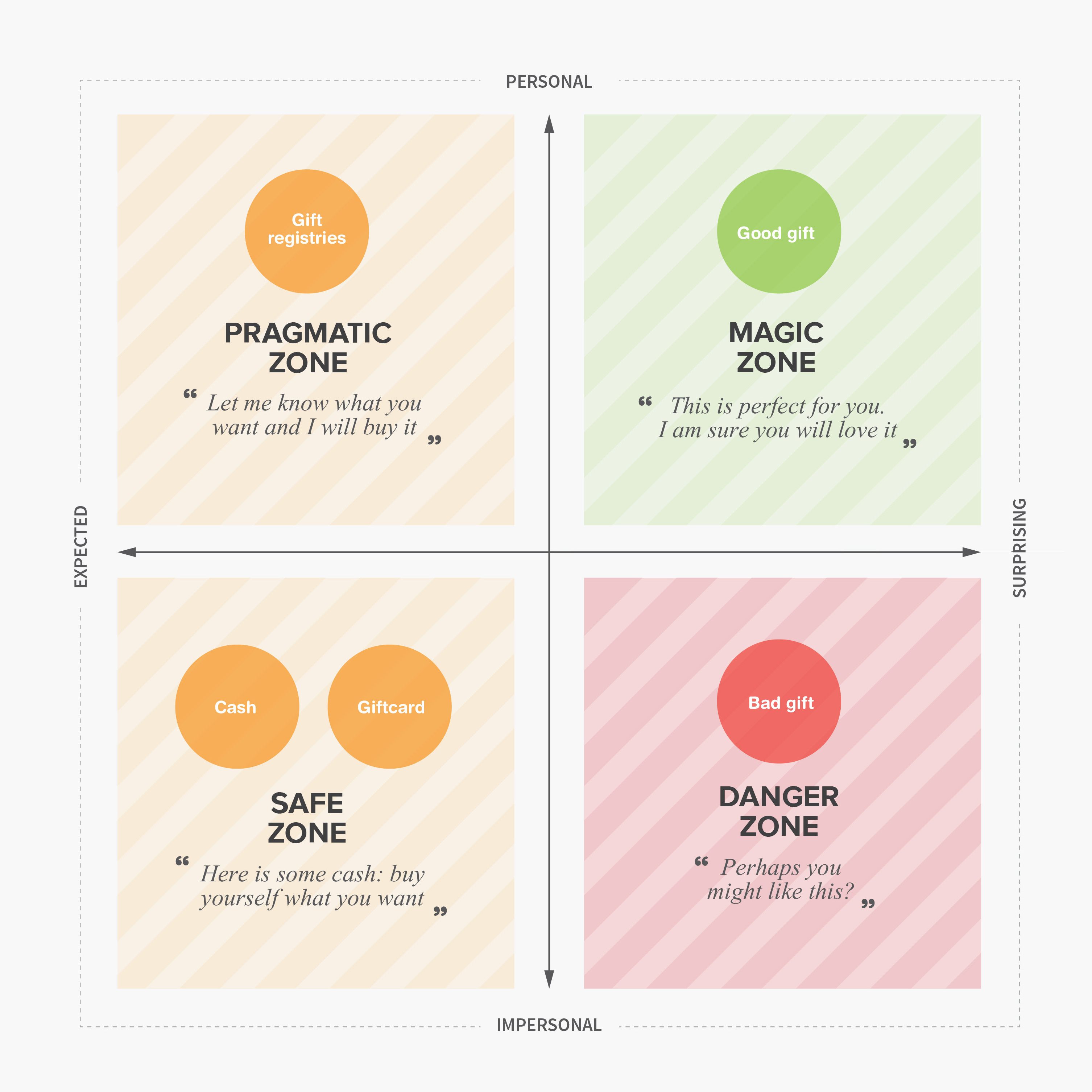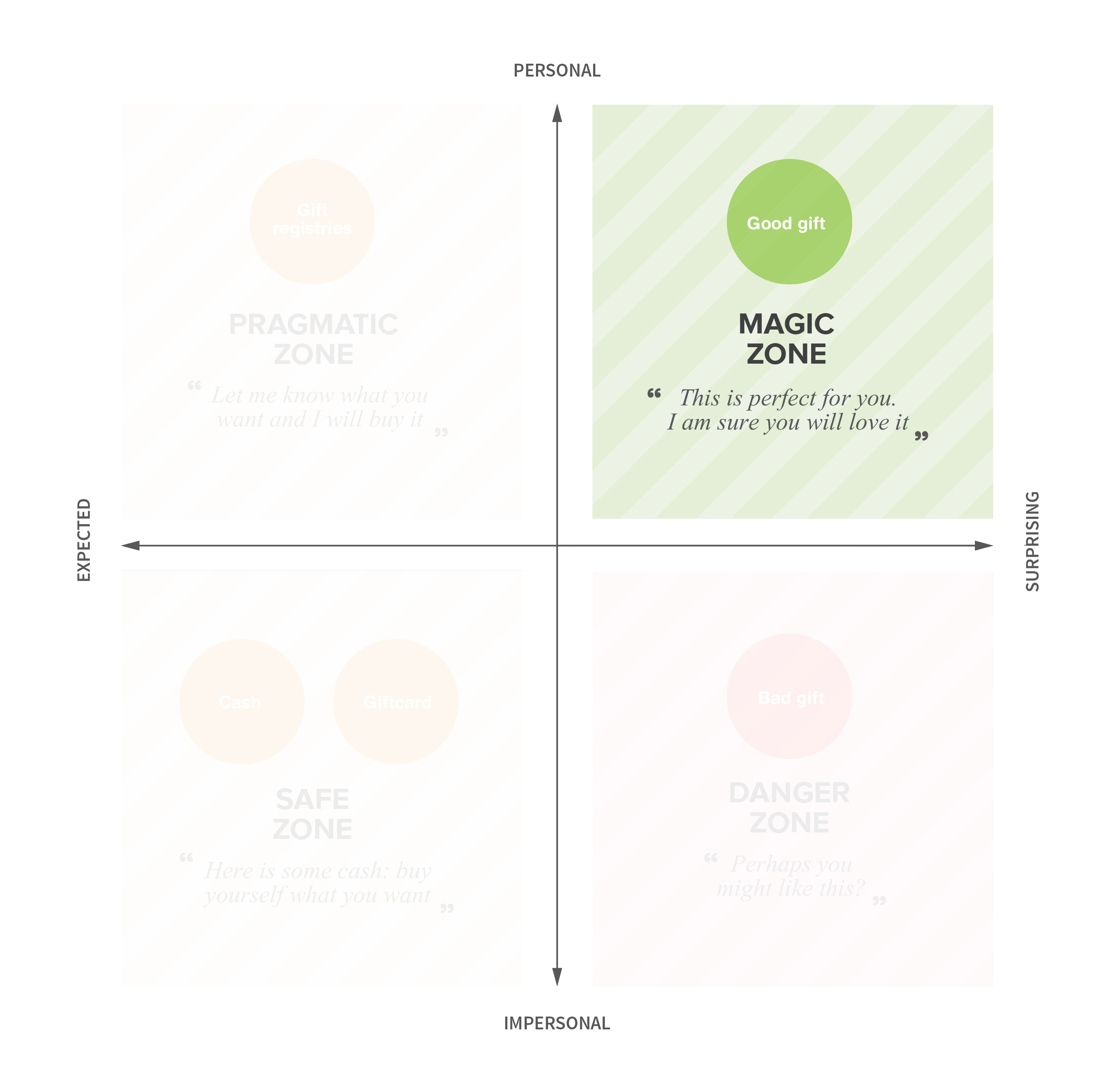Gift-giving is at the base of most societies in the world and has had a fundamental role throughout human history. However even today making a good gift still feels like hitting a jackpot. Why is it so hard?
Gift-giving is an important part of human interaction. It defines our relationships and strengthens (or weakens) bonds with friends, family and lovers.
People give gifts for many different reasons: to express appreciation and care, as a way to influence behaviour, to show off or more often than not to simply follow social conventions, e.g. making gifts for Xmas and birthdays.
Whatever the reason, gift giving is a tricky beast that still creates stress, wasted time and inefficiencies. Why is it like that?
THE GIFT MATRIX

Image 1 – Gift matrix
In this gift matrix I attempted to exemplify the main dynamics behind gift-giving. The vertical axis represents how personal the gift is, while the horizontal axis indicates how surprising and unexpected the gift is for the recipient.
From this matrix originate 4 main zones. Let’s see them in detail.
“Although in our ultra-consumeristic society we are already submerged by tons of products we don’t need, most gifts are made in the danger zone, being ultimately thrown away and ending up in landfills.”

Danger zone
On the lower right we have the danger zone, which results from the combination of an impersonal gift that wishes to be surprising, in other words a Bad gift. Often times, when we rush to make surprising presents at the last minute, without a proper understanding of the needs and taste of the recipient we end up in this zone which will leave both with a mixed feeling of disappointment, embarrassment and despair.

Safe zone
The first reaction we have when trying to avoid the danger zone is to play it safe. Welcome to the Safe Zone. Gifts in this zone are impersonal and expected, typically gift cards or cash. Their generic nature makes them easy to accept and useful, and allow recipients to then proceed buying what they wish.
The downside is that recipients will feel that the giver rushed or didn’t put any effort. Not a nice place to be if you truly care about the recipient.

Pragmatic zone
On the top left corner is the pragmatic zone. Here we find useful gifts that are welcomed although expected. Gifts in this zone are in fact often an expressed request from the recipient. They could be part of a gift registry, the answer to a letter to Santa, or the result of obsessively talking to your partner about something you like on a daily basis. The pragmatic zone differs from the safe zone in that it requires more effort and a deeper understanding of the recipient’s wishes, certainly not something that can be improvised. The downside is however a total lack of the surprising factor that characterises the best, most memorable gifts.

Magic zone
Finally, in the top right corner we find the place to be, the Eldorado of gift-giving, the Magic zone. This zone is characterised by a unique combination of personalisation and surprise that make gifts feel like an unexpected marriage proposal. On the very high top-right corner are those rare gifts where the givers appear to have a deeper understanding of the recipients’ needs than the recipients themselves. The disrupting effect of these gifts can win hearts and even gain you friends for life.
“Only when you put in the hours to do your homework and truly understand the recipient’s background, hopes and needs you can make a great gift.”
To summarise, we can define a great gift as personal and surprising. Personal, as it requires deep knowledge about the personality, values and tastes of the recipient in order to be eventually a useful and appreciated gift. Surprising, as the positive, almost magic emotions caused by an unexpected gift are what differentiate a gift from a purchase or a transaction.
THE 4 ARCHETYPES

Image 2 – Gift matrix & archetypes
To each quadrant of the gift matrix corresponds an archetypal person that thinks and behaves in radically different ways when making gifts. Let’s analyse them one by one.

The Emotional Insecure
In the danger zone lives the emotional insecure archetype. These people often fantasise about making great surprising gifts but lack a real understanding of the recipient and tend to procrastinate. You will often find them asking advises and suggestions to friends or family members to fill their empathy gaps. Gift giving for them is like playing a slot machine: they might hit a jackpot once in a while, but most times they fail.

The Last-minute Rusher
In the safe zone proliferate last-minute rushers. These type of people lead busy lives focused on their careers and hobbies. Gifts for them are a recurring annoyance they need to deal with. Budget is often not a problem, but time is, you will often find them ordering Gift cards online in bulk limiting the time spent for gift-giving to its bare minimum.

The Disillusioned Pragmatic
The pragmatic zone gives name to its main inhabitant, the disillusioned pragmatic. These people typically stopped believing in the magic of gifts since finding out Santa was a scam. They hate making and receiving gifts; the only reason they still do is because social conventions forces them to. They strive for quality, usefulness and hate wasting money. They manage gift-giving as a transaction, their motto being “tell me what you want and I will buy it”.

The Generous gifter
Finally the top right corner, the Magic zone, is populated by rare, generous and altruistic people that put their heart in everything they do, and see gift-giving in its purest form: a way to express love and appreciation to the people they hold dear. Generous gifters are good listeners, they enjoy listening to people’s stories and develop empathy for them. This allows them to make useful gifts that might help the recipient further develop existing passions, discover new interests, connect to meaningful communities.
Conclusions
When birthdays or Xmas holidays come we often struggle between these different archetypes: we might end up being a Generous Gifter with our partner, a Disillusioned Pragmatic with our children, a Last-minute Rusher with colleagues and an Emotional Insecure with acquaintances. It all depends on the situation and how much we care about the recipients.
“In our busy lives it would be nearly impossible to act like a Generous Gifter for all the presents we make, as it takes loads of time and effort to develop empathy for people, understand their needs and choose the right present for them.”
What if technology could help us gain insights, save time and make the whole gift-giving process more fun and enjoyable?


